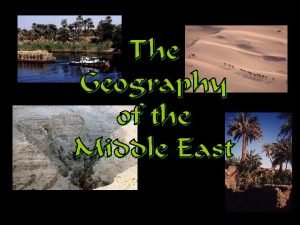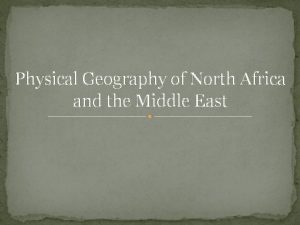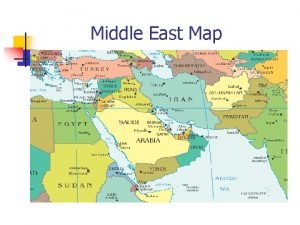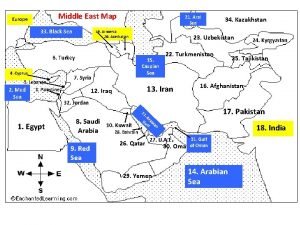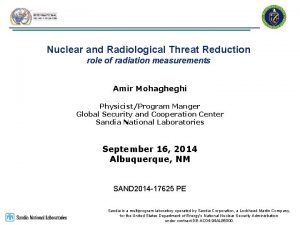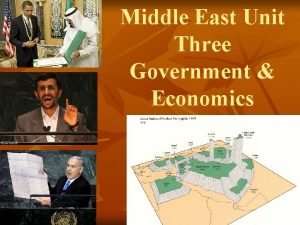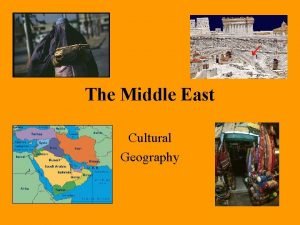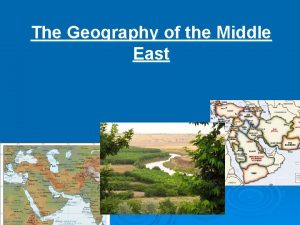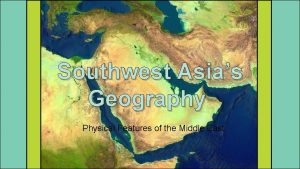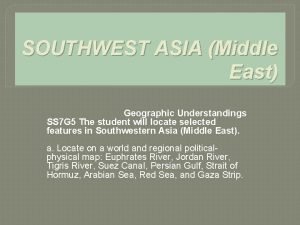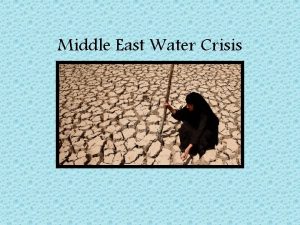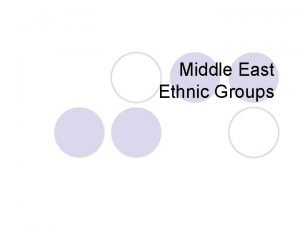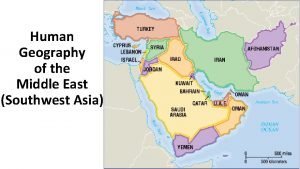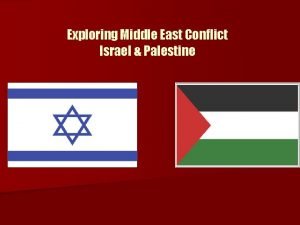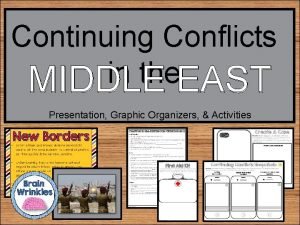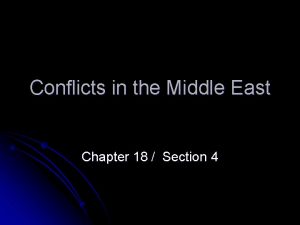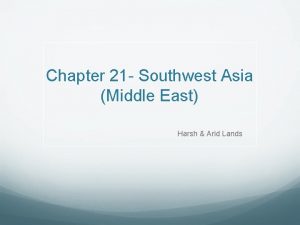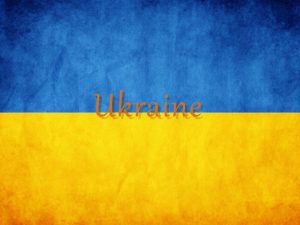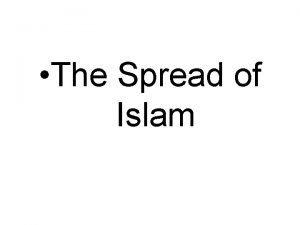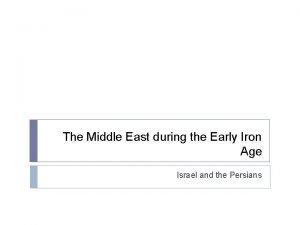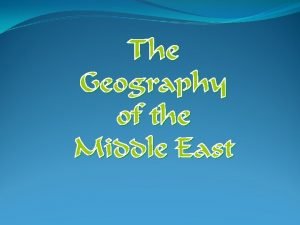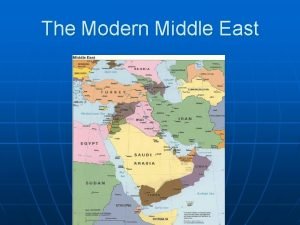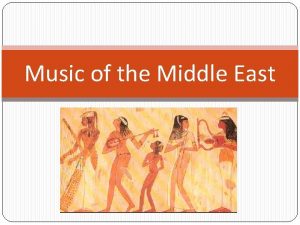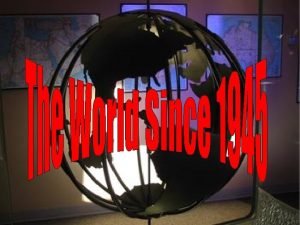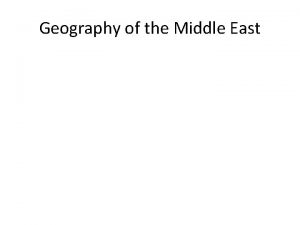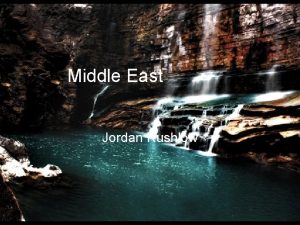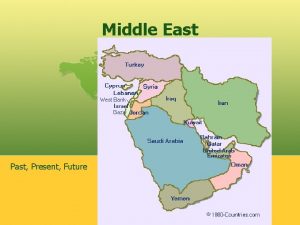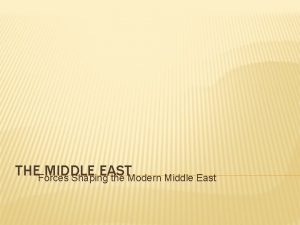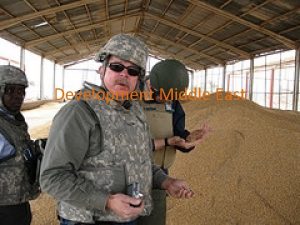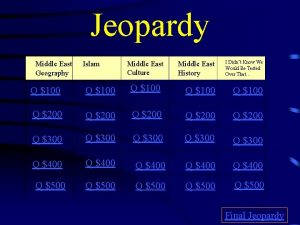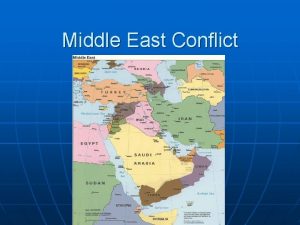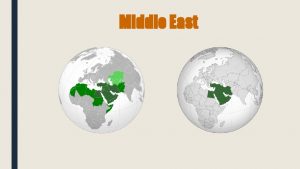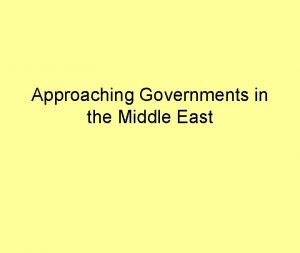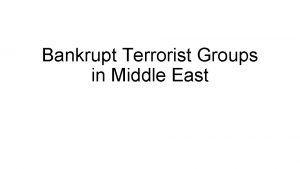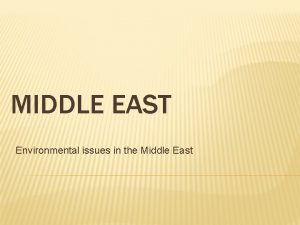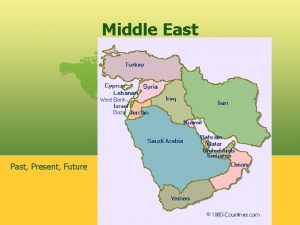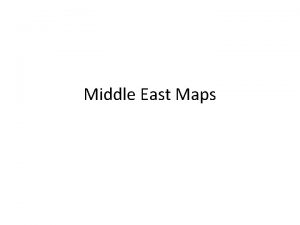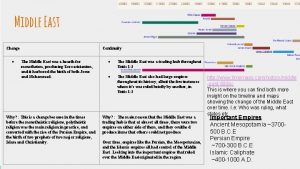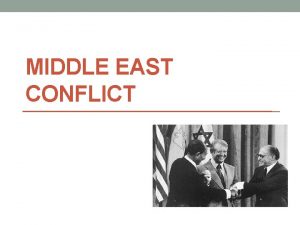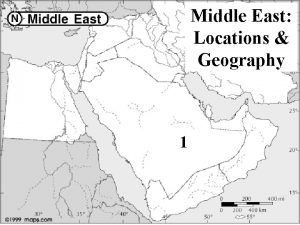Map of the Middle East Middle East The


























- Slides: 26

Map of the Middle East?

Middle East

The Middle East What would replace the Ottoman Empire?

The Middle East https: //www. youtube. com/watch? v=EIv. Fj 0 ab. W 7 Y&list=PLPvk. BEWSL 5 p. Kel. Z 5 r. XDw. FTerxuq 9 rl. UKk&index=5 Zionism (late 19 th century) • a political movement & ideology that supported a Jewish homeland in Israel free from anti-Semitism • Jewish Diaspora – • Biblical homeland? (Jerusalem) • Migrations to northern Europe Early 20 th century – • Jewish migrations to Trans-Jordan and Palestine Theodore Herzl Re-Emerging Colonialism • 1914 - WWI breaks out and the Arabs help the British to win control of the Middle East from the Ottoman Empire, with the hope of gaining independence. • Gradually, the Arabs came to realize that European promises were worthless—France and England had other plans for the Middle East.

Imperial Claims – Why? – Oil, Suez, Mandates… https: //www. youtube. com/watch? v=B 8 NGe 9 p 6 Y_g&index=6&list=PLPvk. BEWSL 5 p. Kel. Z 5 r. XDw. FTerxuq 9 rl. UKk Sykes-Picot Agreement, 1916 • British & French split up Ottoman Empire in secret deal • No provisions for either Jewish or Arab states Balfour Declaration, 1917 • British Foreign Secretary, Lord Balfour, • ‘views, with favour, the establishment in Palestine of a national homeland for Jewish people’ Mc. Mahon Letters, 1918 Britain – Palestine & Trans • British High Commissioner in Egypt states that Jordan Britain ‘promises to recognize and support the France – Syria & Lebanon independence of Arabs in the mid-east region. ’ Paris Peace Conference, 1919 • Mandate System • Middle East is split according to Sykes-Picot • British support Zionist desire for Jewish homeland in Palestine in return for support for British interests in Suez Canal • Arab delegation views this as a betrayal –

The British in Palestine, 1917 -1947 How did Britain’s actions in Palestine lay the groundwork for the on-going conflict between Jews and Arabs in the Middle East? 1920 – 1 Jew for Every 10 Arabs 1947 – 1 Jew for every 2 Arabs • Palestinian-Arab Revolt (1936 -39) • British White Paper (1939) • Strict limits on Jewish immigration to Palestine • Ends Jewish purchasing of land • Br. do not agree that Palestine should be Jewish state ‘Exodus’ (1945 -57) • Holocaust • Aliyah Bet : Illegal Jewish Immigration • British Naval Blockade • Quarantine Camps (Cyprus) • Jewish ‘freedom fighters’ • Britain turns to the United Nations (terrorists? ) (1947) Why should he (Palestinian) give away half of is land, when in his mind he owns it all? • Can British hold on to

Partition 1947 – United Nations Partition Plan • David Ben-Gurion, a Zionist leader, accepts plan • Arab League (1945) rejects partition plan • Creation of Jewish homeland • Remainder of Palestine to Arabs • Jerusalem an UN administered city • Ben-Gurion declares a ‘State of Israel’ reborn 1948 – Arab-Israeli War • Egypt, Jordan, Syria, Iraqi & Saudis invade ‘Israel’ 1949 – Armistice signed • West Bank (Jordan) • Gaza Strip (Egypt) • Palestinian refugees (diaspora) • 100’s of 1000’s escape/exiled to nations around the Middle East • West Bank Arab-Israeli Conflict from 1947 • Gaza http: //www. youtube. com/watch? v=D 0 Il. Cl 9 ODiw • Jordan • Syria • Lebanon

Israel War of Independence/Palestinian War (1948) Demographic Change: • 700 000 Palestinian (Arab) refugees flee or were expelled from area that became Israel • 700 000 Jews flee or were expelled from Arab states in the region; migrate to Israel Historiography – • In the West, the majority view was of a tiny group of vastly outnumbered and illequipped Jews fighting off the massed strength of the invading Arab armies • The Palestinians regard Israelis as the conquerors and themselves as the true • The Israelis, whether conquerors or not, victims of the first Arab-Israeli war were the indisputable victors in the 1948 which they call al-Nakba or the disaster. war which they call the War of Palestinian historiography reflects these Independence. Because they were the perceptions. victors, among other reasons, they were able to propagate more effectively • Palestinians, in spite of fellow Arab than their opponents their version of this support in various wars, are not

The Uneasy Truce 1949 – Israel and Arab states sign a truce • For Arabs – an inglorious defeat • Palestinians formed organizations and attacked Israel from neighbouring states (Lebanon, Jordan, Syria) 1951 - Israeli Defense Force (IDF) begins raids on Palestinian and Jordanian villages in the West Bank • 1953 – Qibya Massacre Ariel Sharon 1952 – Egypt sees King Farouk overthrown by Egyptian Army • Military regime led by General Naguib, but Egypt is

Suez War, 1956 Key Issues: • USA and USSR enter Middle East conflict • Think: Cold War – ‘sphere of influence’ • Eisenhower Doctrine • Use of military force if requested by any Middle East nation (in order to prevent further Soviet expansion) • Exit of France and Britain as meaningful players • Closure of Suez Canal (to 1957) and impact of For Israel – • Israeli possession of the Gaza Strip • Emerged victorious yet again • Demonstrates military prowess of • Role of United Nations Israel • Pearson’s Peacekeepers (UNEF) • Its stubborn refusal to withdraw • El Fatah – Palestinian Liberation Organization without guarantees, even in (PLO) defiance of the United States and • Leader: Yasser Arafat United Nations, ended all Western efforts, mainly American and British • Arab/Palestinian frustration with results of ones, to impose a political war(s) settlement in the Middle East • ‘terrorism’ becomes and remains a permanent

Six Day War, 1967 Background: • PLO attacks of Israelis Escalation: • Israeli raids into Jordanian West Bank • Israeli flights/aerial clashes over Syria • Syrians launch rockets at Israeli civilian targets 5 -10 June 1967 – • Israelis respond • Israel stages ‘preemptive attack’ catching most of against Syrian the Egyptian Air Force on the ground, destroying it positions in the Golan • Israel wins ‘decisive victory’ Heights • Occupies: West Bank – Golan Heights – Gaza • Egypt blocks Israeli Strip shipping - Strait of Significance: Tiran • USSR mobilizes forces to assist Egypt • Egypt mobilizes army • USA becomes the staunchest of allies with Israel https: //www. youtube. com/watch? v=1 wo 2 TLl. Mhiw along Sinai Peninsula • Suez Canal closed to 1975 • UN Forces ordered • Palestinians give up trying to kick Israelis out/call for

Yom Kippur War, 6– 25 Oct 1973 • Egypt & Syria launch surprise coordinated attack on Israeli occupied territories (Sinai, Golan Heights), on Yom Kippur, the holiest day in Judaism • Initially, Egypt regained control of Sinai – • Israelis, push back Syrians all the way to Damascus • Egyptian President Anwar Sadat fails in second offensive to fortify position in Sinai • Israelis push Egyptians back across Sinai, encircle Suez and slowly begin advance on Cairo Significance: • Militarily, this war was a draw – BUT • Israelis had once again routed Arab alliance • Yet, still no guarantee Israelis could dominate • Arab oil embargo: OPEC • Arabs are in no position to fight Israel and US, so they cut oil production thus squeezing US economy

Camp David Accords Peace in the Middle East? • Sadat (Egypt) realizes that an Israeli state backed by the U. S. could not be defeated, so he begins negotiations with Israeli PM Menachem Begin (against the advice of the other Arab states) • Sadat (1977), first Arab leader to go to Israel • 1979 - US President Jimmy Carter & Secretary of State Henry Kissinger broker the Camp David Peace Accords with Sadat & Begin Outcomes: • Israel and Egypt agree not to make war • Issue of Palestinian refugees is not addressed. • Egypt is expelled from OPEC • Sadat is assassinated by his own honor guard • Begin is shot (not killed) by a Israeli nationalist

Lebanon • By 1975 – 300 000 Palestinian refugees • PLO based out of Beirut, is a kind of ‘state within a state’ • Continual violence near the Lebanese border occurred between Israel and the PLO starting from 1968 • 1980 -82 United Nations Interim Force in Lebanon (UNIFIL) • Ceasefire: Yasser Arafat, leader of the PLO, tries to maintain control, but the splits in the PLO are along fundamental lines based on how to deal with Israel • Hezbollah (Iranian backed, Syrian support) • Palestinian Liberation Front (PLF) (1961) • Radical PLO guerillas in southern Lebanon rocket attacks of Israeli settlements along the Israeli-Lebanon 1982 -85 – Israeli invasion of southern Lebanon border Significance: • Israeli strategic and politicalhttps: //www. youtube. com/watch? v=D 0 Il. Cl 9 ODiw failure • Sabra and Shatila Massacre (Ariel Sharon) • Syrian political victory – Hafez Al-Assad (Bashar’s daddy -oh) • Increased Syrian influence in Lebanon • PLO expelled from Beirut (to Tunisia) • 200 American Marines killed during truck bombing of

Intifada a key concept in contemporary Arabic usage referring to a legitimate uprising against oppression First Intifada, 1987 • Palestinian uprising against the Israeli occupation of the West Bank and Gaza • Civil disobedience, strikes, boycotts, throwing of stones and Molotov cocktails at IDF • Over six years the IDF killed an estimated 1150– 1200 Palestinians. Among Israelis, 100 civilians and 60 IDF personnel were killed. • Intra-Palestinian violence was also a prominent of 2000 -2005 the Intifada Second feature Intifada, • Begins when Ariel Sharon made a visit to the Temple Mount, seen by Palestinians as highly provocative; and Palestinian demonstrators, throwing stones at police, were dispersed by the IDF, using tear gas and rubber bullets • Both parties caused high numbers of casualties among civilians as well as combatants: the Palestinians by numerous suicide bombings and gunfire; the Israelis by tank and gunfire and air attacks, by

Israeli-Palestinian Conflict https: //www. youtube. com/watch? v=i. RYZj. Ou. Unl. U

Middle East Peace Process • Since the 1970 s there has been a parallel effort made to find terms upon which peace can be agreed to in both the Arab–Israeli conflict and in the Palestinian–Israeli conflict. Some countries have signed peace treaties, such as the Egypt–Israel (1979) and Jordan–Israel (1994) treaties, whereas some have not yet found a mutual Some difficulties with the peace process basis to do so. • both Israelis and Palestinians have grown weary of the process American Involvement – • All recent US Presidents have maintained a • Israelis point out the fact that the Gaza policy that Israel must give up some of Strip is fully controlled by the Hamas the land that it conquered in the 1967 who do not want peace with a Jewish war in order to achieve peace; that the state Palestinians must actively prevent terrorism; and that Israel has an • The Palestinians point out to the unconditional right to exist. extensive and continuing Israeli settlement effort in the West Bank restricting the area available to the Palestinian state

ATTEMPTS TO MAKE PEACE Oslo Accord (1993) • a plan discussing the necessary elements and conditions for a future Palestinian state "on the basis of Security Council Resolutions 242 • Adopted after 1967 Six Day War – (i) Withdrawal of Israel armed forces from territories occupied in the recent conflict; Yitzak Rabin, Pres. Bill Clinton, Yasser Arafat • Palestinians achieved selfgovernance of major cities in the West Bank and the entire Gaza Strip • Israel maintained and continues to maintain a presence in the West Bank for security reasons • 2013 Israel still has control of 61% of the West (ii) Termination of all claims or states of belligerency and respect for and acknowledgment of the sovereignty, territorial integrity and political independence of every State in the area and their right to live in peace within secure and recognized boundaries free from threats or acts of force Problems – • Jewish claims to occupied territories by Jewish settlers that have made their home in areas gained by Israel in the Six Day War • Internal Israeli politics between ‘hawks’ and http: //www. youtube. com/watch? v=gw 3 u. Oo 21 f. FA ‘doves’ https: //www. youtube. com/watch? v=i. RYZj. Ou. Unl. U&lis

Middle East

Interwar Period Turkey (1923) • Treaty of Lausanne • Mustafa Kemal Ataturk Westernization & Nationalism • compulsory secular education • western clothing • Women unveiled, given full citizenship and the right to vote Iran • Rezah Khan (1921) • ‘Shah’ (1925) Reforms: • Secularization • Education • French Civil Code • Trans Iranian Rail • Pahlavi Dynasty (‘ 79 Iranian Revolution) Western biases? Ignorance of Islamic religion? • West separated church and state • Middle East • To varying degrees, there is the belief that religion and government can/should be interconnected • West has rejected this system • Not ‘right or wrong, ’ but rather, whether we understand how Muslims view the role of the world powers during the last century -

Case Studies: Libya & Iran 1969 – Colonel Moamar Gaddafi leads overthrow in Libya • Gaddafi supports Islamic Fundamentalists & PLO • Blends Arab Nationalism with “Islamic Socialism” • For his anti western policy, Gaddafi gains a negative reputation in western media and diplomatic circles http: //www. biography. com/people/muammar-al-qaddafi-39014 Gaddafi changes course…. • Following the attacks of 11 September 2001, Gaddafi made one of the first, and firmest, denunciations of Al-Qaeda bombers by any Muslim leader – Gaddafi is worried for his regime • Arab Spring (2009) and Libyan Civil War (2011) • Gaddafi captured, beaten to death 1979 Iranian Revolution – http: //www. youtube. com/watch? v=u. HIHUKwh 3 r. Q • Islamic Fundamentalists overthrow wealthy US puppet autocrat, the Shah of Iran • Ayatollah Khomeini leads fundamentalists in overthrow and the taking of US Embassy hostages – held for one year – this is a huge embarrassment to USA and Pres. Jimmy Carter (leads to Carter’s defeat to Ronald Reagan in 1980)

Iran-Iraq War, 1980 -88 Brutal War – Not since WWI were chemical weapons were used. With the Iranians buying arms from the USSR and the Iraqis buying arms from the US and British, the conflict raged on with both sides suffering huge losses and almost bankrupting both nations. • Saddam Hussein (Sunni) is allied with the USA • The war began when Iraq invaded Iran, launching a simultaneous invasion by air and land into Iranian territory on 22 September 1980 following a long history of border disputes, and fears of Shia insurgency among Iraq's long-suppressed Shia majority influenced by the Iranian Revolution. • Iraq was also aiming to replace Iran as the dominant Persian Gulf state.

http: //www. youtube. com/watch? v=7 FBwj 0 FJf. Ag http: //www. history. com/topics/osama-bin-laden Afghanistan, 1980 -89 1980 – Soviet invasion of Afghanistan Soviet equivalent to US Vietnam War Russia was looking to expand its southern border by invading Afghanistan USSR quickly take control of urban centers, but are unable to control countryside Mujaheddin (soldiers of God), supplied by the USA fight a guerilla war against the Soviets KEY: In the disorganization that followed the Soviet withdrawal, Islamic Fundamentalism grew. The new government, Taliban, took control and began a hard-line Islamic state that actively supported Islamic Fundamentalism (i. e. Al Qaeda) Like Vietnam, the USSR won all major battles, but lost numerous soldiers to the Mujaheddin. 1989 the USSR pulls out of Afghanistan

http: //www. biography. com/people/saddam-hussein-9347918#awesm=~o. EPl. A 5 QNef. Wcv. I Persian Gulf War, 1990 -91 Iraq, led by Saddam Hussein, invades Kuwait, claiming historical territorial rights and accuses Kuwait of drilling for oil under Iraq The west, led by George Bush (I), builds up a massive coalition and forces Iraq out of Kuwait Although the bulk of Iraqi forces are destroyed, the coalition does not take Baghdad and leaves Saddam Hussein in power. US imposes economic sanctions in Iraq. This has one major effect: the people of Iraq begin to starve. Fundamentalism grows NOTE: At this point in global affairs, the USSR is now broken-up. Although they protest the western actions, they no longer have international teeth.

http: //www. history. com/topics/9 -11 -attacks http: //www. cbc. ca/player/Shows/Doc+Zone/2012 -13/ID/2308210709/ World Trade Center, 9/11/01 1989 – Al Qaeda founded Al Qaeda operates as a network comprising both a multinational, stateless army and a radical Sunni Muslim movement calling for global Jihad (holy war) Osama Bin Laden is commander or emir 9/11/01 - a series of coordinated suicide attacks by Al Qaeda upon the USA United States responded to the attacks by launching the War on Terror, invading Afghanistan to depose the Taliban, who had harbored al-Qaeda terrorists, and enacting the US Patriot Act. Many other countries also strengthened their anti-terrorism legislation and expanded law enforcement powers.

 Kalahari desert on africa map
Kalahari desert on africa map Middle east latitude and longitude
Middle east latitude and longitude Physical features of the middle east map
Physical features of the middle east map Middle east map
Middle east map Black sea on middle east map
Black sea on middle east map Middle east language map
Middle east language map Middle east map with countries
Middle east map with countries The middle east map
The middle east map Middle east map
Middle east map What is the horizontal movement of air called
What is the horizontal movement of air called East is east and west is west
East is east and west is west Ethnic groups in the middle east
Ethnic groups in the middle east Why is it called the middle east
Why is it called the middle east Inlet of indian ocean between africa and asia
Inlet of indian ocean between africa and asia Why is the middle east so dry
Why is the middle east so dry Gope
Gope Ethnic groups in the middle east
Ethnic groups in the middle east Southwest asia geography
Southwest asia geography Middle east war
Middle east war Gosforth east middle school
Gosforth east middle school Conflicts in the middle east comprehension check
Conflicts in the middle east comprehension check Chapter 18 section 4 conflicts in the middle east
Chapter 18 section 4 conflicts in the middle east Chapter 21 section 2 climate and vegetation
Chapter 21 section 2 climate and vegetation Biotime 7
Biotime 7 Location of ukraine
Location of ukraine Middle east before islam
Middle east before islam Zoroastrianism teaching
Zoroastrianism teaching

